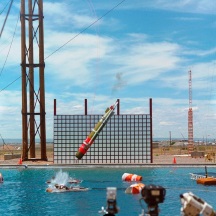The Water Impact Facility at Sandia National Laboratories in Albuquerque, New Mexico provides a controlled environment for high-velocity water impact testing, gravity-assisted drop testing and underwater testing.
A 300-foot drop tower stands next to a 120-foot-wide by 188-foot-long by 50-foot-deep lake. A total depth of 80 feet for underwater testing can be obtained via a 6-foot-diameter, 30-foot-long steel pipe at the bottom of the lake.
Objects weighing up to 3,000 pounds can be subjected to free-fall drops or rocket-assisted pulldowns from angles of 30 to 90 degrees.

Mobile gas guns with a 6-inch and 16-inch bore barrel can be used to launch scale models into the lake at angles of approximately 15 to 45 degrees from horizontal.
Tests are designed to simulate and evaluate special scenarios to aid in such activities as prototype development, or computer modeling code development or validation.
The Water Impact Facility has exceptional instrumentation capabilities. The facility uses high-speed video cameras for underwater and surface data coverage photometrics. Underwater and surface instrumentation can be provided via hardwire and onboard data recorders to gather data from a variety of transducers at low or high speeds of 5 MHz per channel.
These capabilities can meet a broad range of customer needs for a single test or a series of testing and evaluation scenarios.
This unique facility has been used to conduct tests involving underwater detonations, ice penetrators, ice puncture, torpedo impacts, pressure vessels, mass distribution, sonar, model verifications, and shipping containers. Today, the facility can also test:
- Full-scale and scale-model items
- Items containing radioactive materials
- Items containing high explosives for water impacts
- Up to 1.5 pounds of C4 for underwater detonation
Water Impact Testing
The hoisting system at the 300-foot tower consists of a main load cable and a movable trolley used to lift test items (weighing up to 3,000 lbs) to the desired height. Test items can be hoisted to and released from a maximum height of approximately 265 feet. Full-size test items can be impacted into the water at free-fall velocity, or they can be accelerated to higher velocities using a rocket pulldown technique. Water impact angles of 30 to 90 degrees can be achieved with the pulldown technique. An underwater net system is used to ensure a soft catch and recovery of the test item.
Our divers are experienced divers and are trained and certified to perform any type of rigging, set up, or recovery – both at the Water Impact Facility and elsewhere.